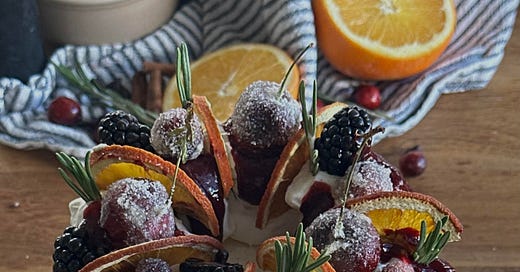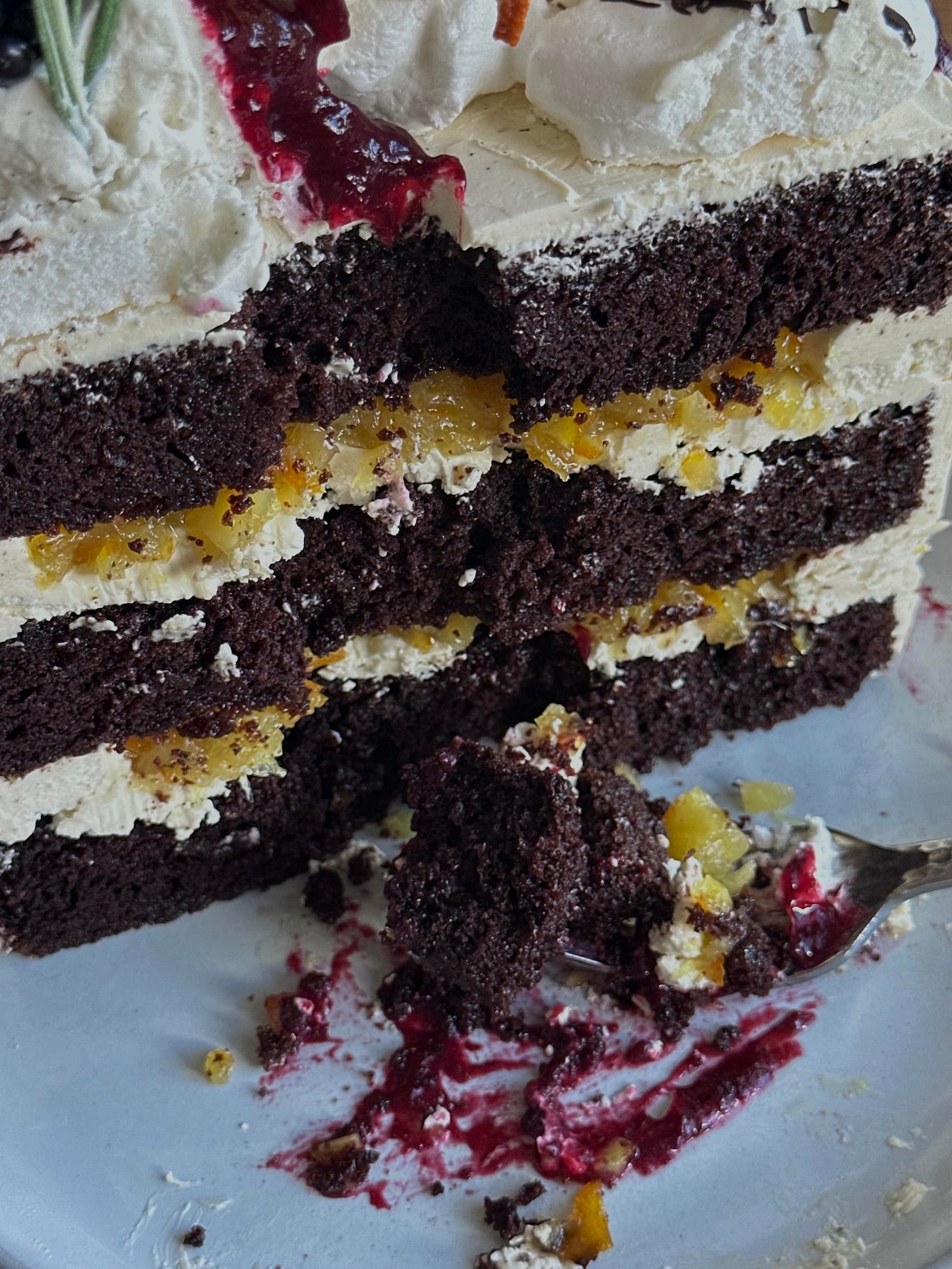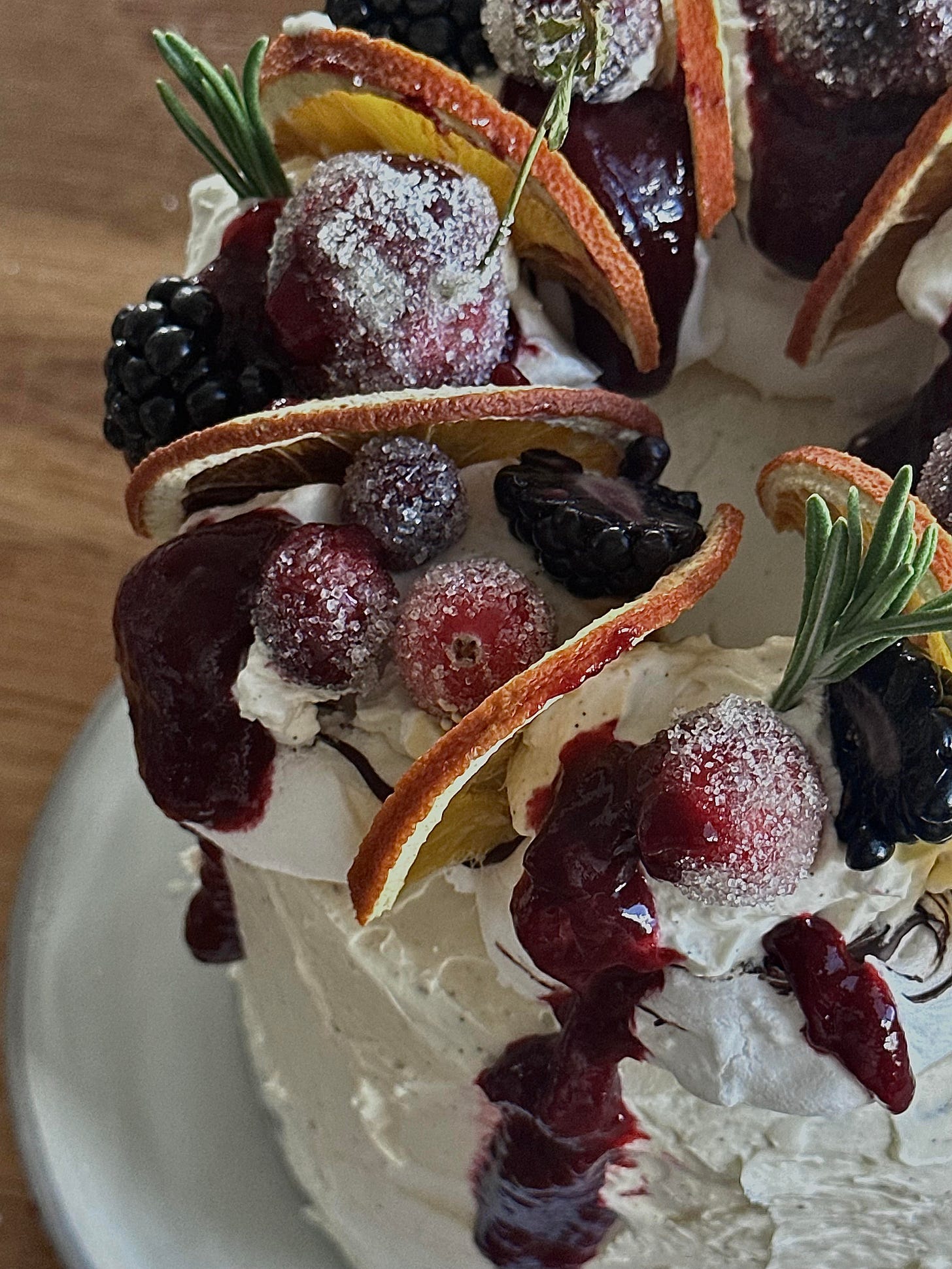Christmas Cake: Part 2
Dark chocolate olive oil sponge brushed with a vanilla bean cake soak, filled with orange marmalade, & coated in a lush chamomile vanilla bean buttercream. Decorated with a mini pavlova wreath.
Happy holidays! This is the cake I brought to my family’s Christmas dinner this year. I was considering making a pavlova wreath instead of a cake, but then realized I could just do both!
This cake combines the classic winter flavors of chocolate and orange, enhanced with a chamomile and vanilla bean frosting. The base for thus cake is my dark chocolate olive oil sponge recipe (of course), brushed in a simple vanilla cake soak, before being filled with an easy navel orange marmalade filling. A citrus curd would also be lovely here if marmalade isn’t really your style. I used a Swiss meringue buttercream for a light, sweet finish, but the focal point of this cake is the topping.
I’ve topped this cake with a mini chocolate swirled pavlova wreath. This wreath was then adorned with vanilla whipped cream, blackberry and cranberry puree, dried orange slices, as well as sugared and fresh fruits. The pavlova adds a light crunch to the cake making the eating experienced, balanced, interesting, and sweet; the perfect addition to any holiday dessert spread.
Dark Chocolate Cake with Orange & Chamomile
Ingredients:
Makes a single 3 tier 6-inch cake
For the cake:
1 batch Dark Chocolate Olive Oil Cake, baked in 3 6-inch tins, cooled
For the cake soak:
1/2 cup granulated sugar
1/2 cup water
1 tablespoon vanilla extract
For the marmalade:
2 navel oranges, chopped into large chunks, rind included
1/2 lemon (zest and juice)
2 cups granulated sugar
3 tbsp water
For the buttercream:
1 batch Swiss meringue buttercream
1 chamomile teabag
1 tablespoon vanilla bean paste
For the pavlova:
1 egg white
1 teaspoon lemon juice
1/2 teaspoon cornstarch
45g granulated sugar
45g powdered sugar
50g dark chocolate chips, melted
Garnishes (optional):
Whipped cream
Fruit puree
Dried oranges
Rosemary
Sugared cranberries
Sugared cherries
Blackberries
Method:
For the cake:
Bake the cake as written and allow to cool completely before continuing.
For the cake soak:
Combine all ingredients in a heat-proof bowl or mug.
Microwave for 1-2 minutes or until sugar has completely dissolved.
Set aside in the fridge until ready to use. (You can also make this in a small saucepan on the stovetop but I’ve found this method to be faster and easier with an identical result.)
For the marmalade:
In a food processor, add the oranges.
Pulse until the oranges are in small pieces (not a puree).
Combine the pulverized oranges and remaining ingredients in a medium saucepan over high heat.
Bring mixture to a boil, then reduce to a simmer. Simmer for 30-40 minutes or until thickened and jammy. The oranges should taste almost candied.
Set aside until ready to use. Be sure the marmalade is cool before assembling.
For the buttercream:
Add the teabag into the egg whites and sugar before putting over the bain marie.
Once you remove the mixture from the heat, remove and discard the teabag.
Continue the recipe as written, adding the vanilla bean paste with the vanilla extract.
Set the buttercream aside until ready to use.
For the pavlova:
Preheat the oven to 200F.
In the metal metal bowl of a stand mixer fitted with the whisk attachment, add the egg white. You can also use a hand mixer if necessary.
Whip the egg white on high speed.
In a small bowl, whisk together the lemon juice and cornstarch.
Once the egg white is beginning to look frothy, pour in the lemon juice/cornstarch mixture while the mixer is still whipping. Continue whipping on high.
Once the egg white has reached soft peaks, begin adding the granulated sugar, bit by bit, with the mixer is still running.
Once the sugar has been entirely added, continue whipping on high until you reach stiff peaks. Remove the bowl from the stand mixer.
Sift the powdered sugar over the meringue before carefully folding in with a rubber spatula.
Using either a spoon or a piping bag, transfer the meringue to a baking sheet lined with parchment paper.
Shape your meringue into a wreath, being sure it is no bigger than your cake (6 inches). The meringue will not change shape while it bakes so be sure to form your meringue wreath exactly how you want your finished pavlova. Set aside.
In a small microwave safe bowl, add your chocolate chips.
Microwave your chocolate chips for 30 seconds, then stir.
Place your bowl back into the microwave in 10 second intervals, stirring in-between, until your chocolate chips are completely melted.
Drizzle the melted chocolate over the meringue. Then, using a skewer or toothpick, swirl the chocolate into the meringue.
Bake the pavlova on the lower rack of your oven for 90 minutes. Once the time has elapsed, turn off the oven but do not remove the pavlova. Leave the pavlova in the oven to cool for an additional hour.
Remove the pavlova and allow to cool completely on the counter before assembling.
Assembly:
Place your first layer of cake on your serving plate or cake board.
Brush generously with your cooled cake soak. Let sit for 1-2 minutes.
Add a scoop of your buttercream and spread evenly across your layer of cake.
Create a dam around the outside rim of the cake layer by either piping or indenting the buttercream with an offset spatula. The dam is essential to keep the marmalade from spilling out the sides.
Fill the dam with your compote, spreading evenly.
Add your next cake layer, pressing down gently. Repeat steps 31-34.
Add your final cake layer.
Brush the cake layer with your cake soak and let sit for 1-2 minutes.
Add a large scoop of buttercream and thinly coat the entire cake as evenly as possible to create a crumb coat.
Place your thinly frosted cake in the refrigerator for 15 minutes, or until the frosting has hardened.
Once the crumb coat is solid, add your remaining buttercream and evenly coat the cake.
Garnish your cake with the pavlova on top and any additional toppings as desired and enjoy :)







